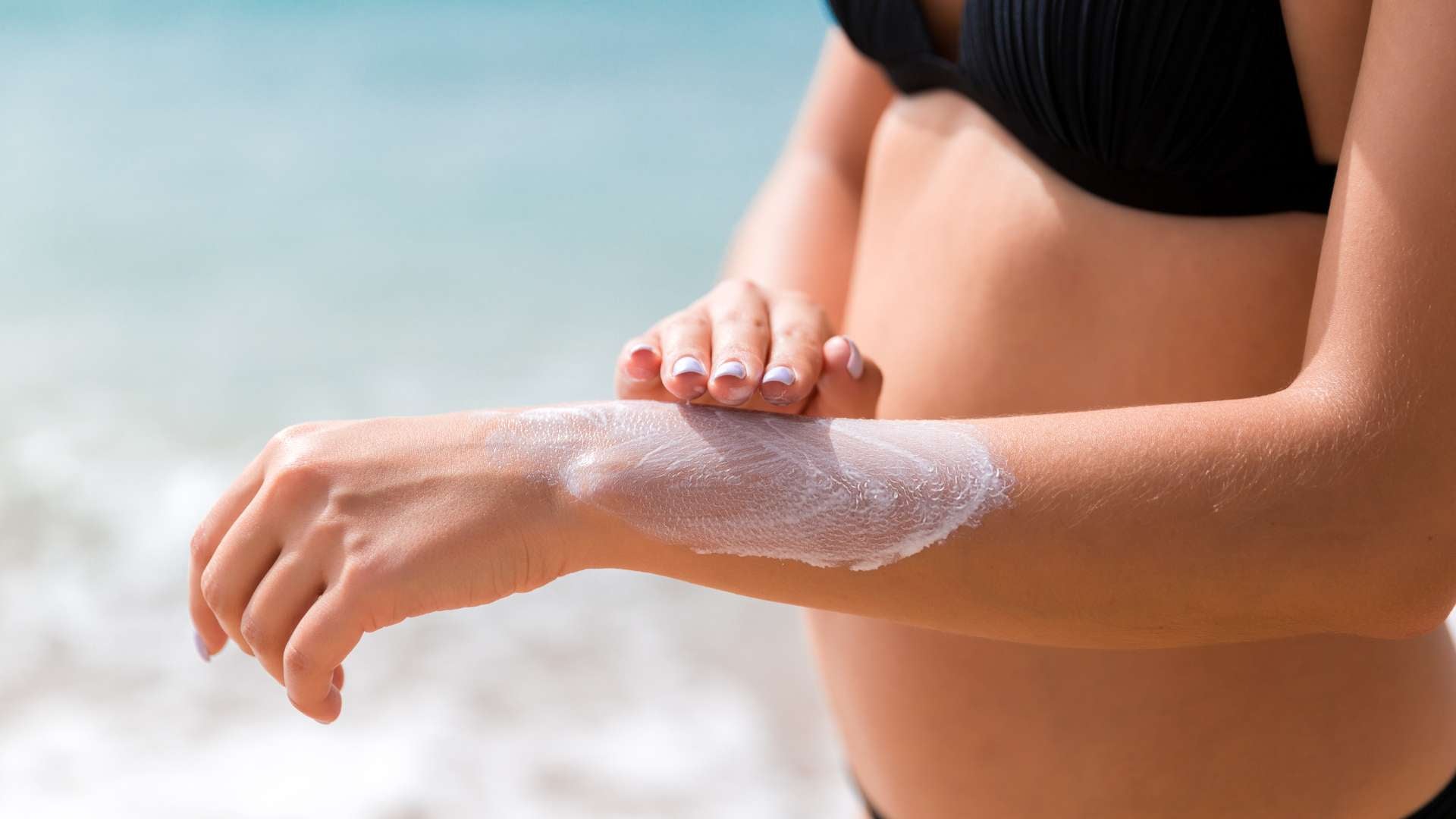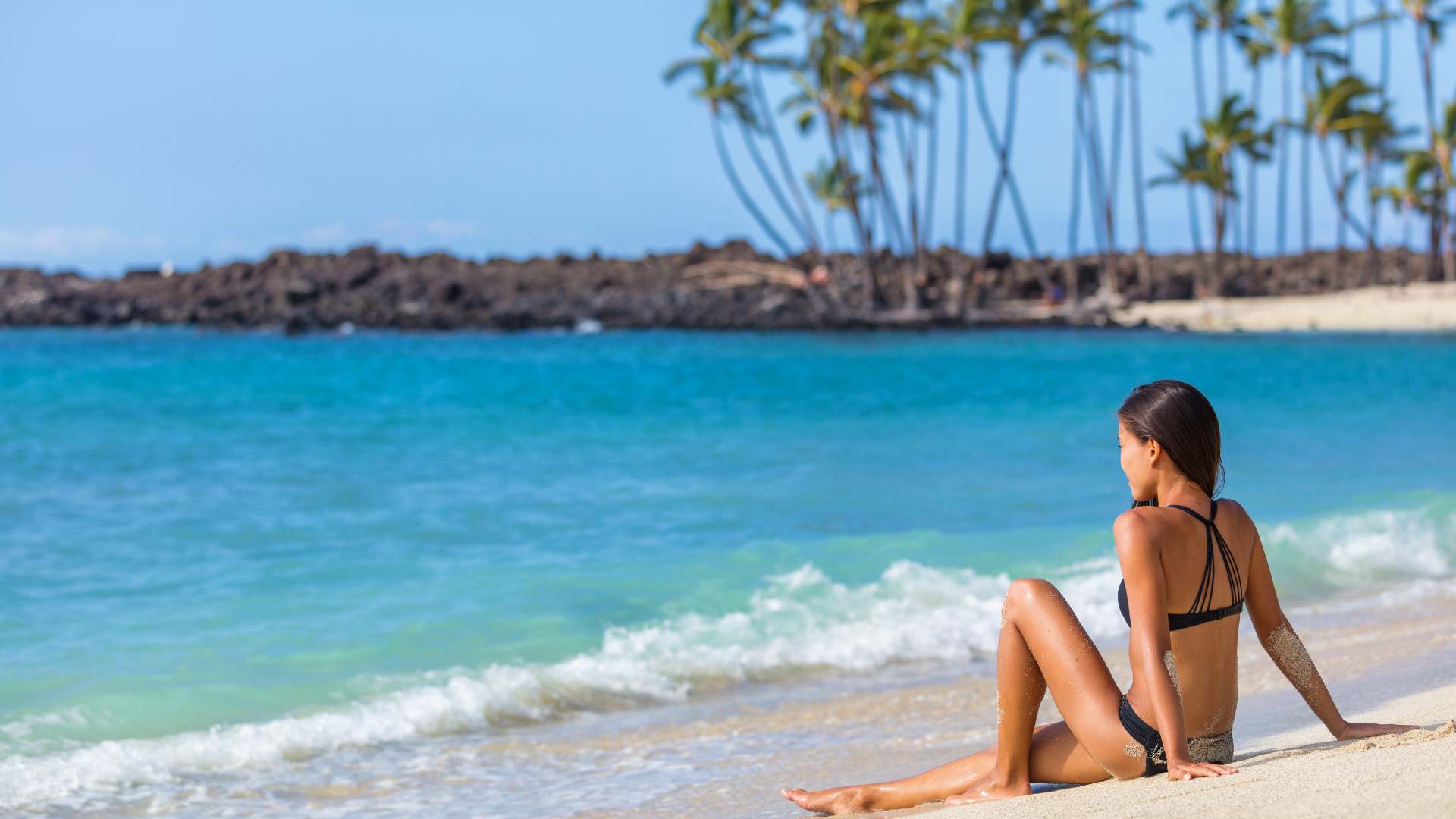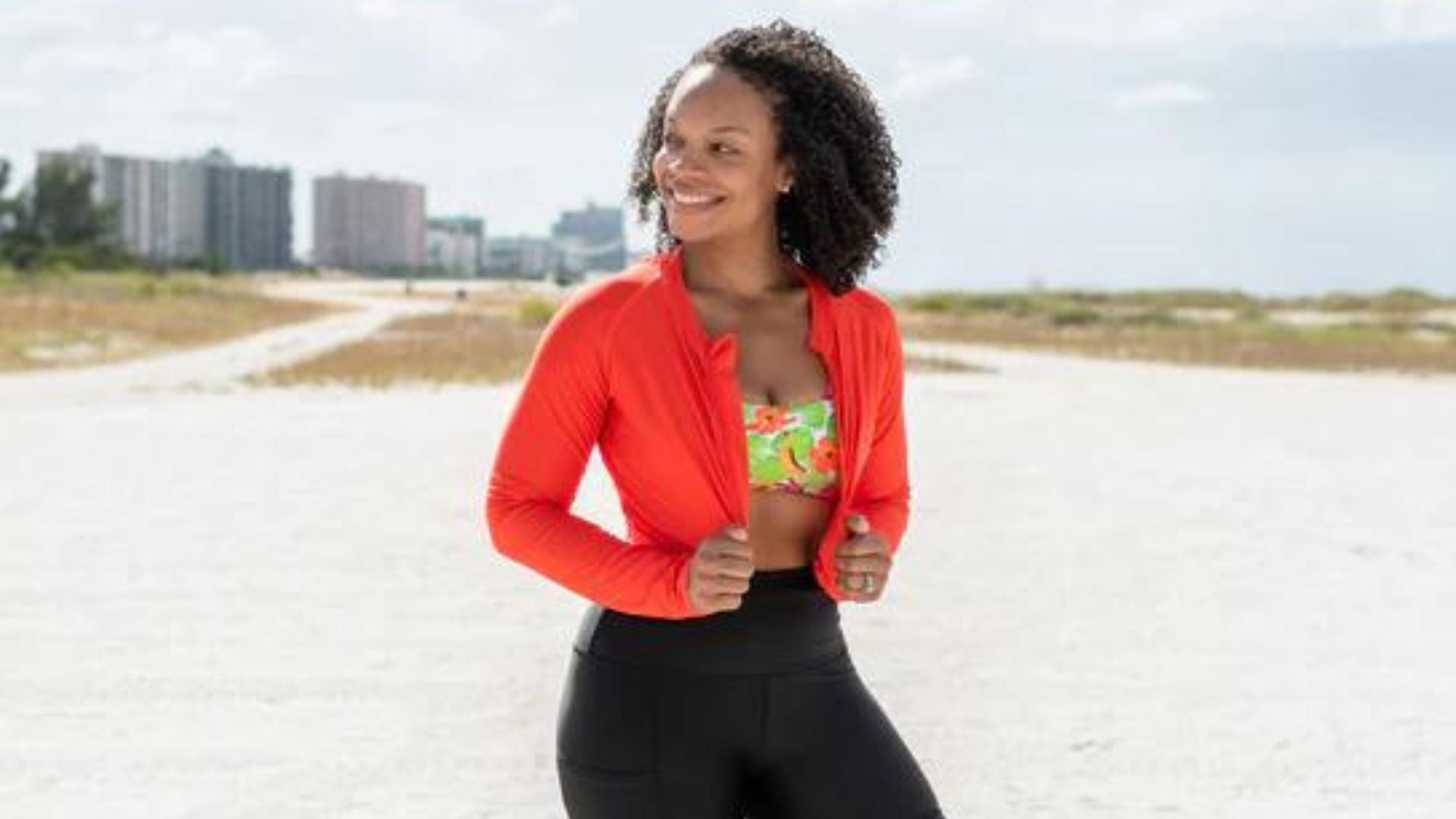
How long does it take to tan in UV 7?
UV 7 sun provides a quick tan but significantly increases your sunburn risk. Your skin may tan in just 10 to 20 minutes under this strong sunlight.
Let’s discover sun protection strategies and how to maintain skin health while tanning.
Quick links:
Factors affecting tanning time
Before your next holiday or beach trip, get some SwimZip sun-protective swimwear. Our line protects you from UV rays while making you look fantastic.
What is the UV index?
The UV index measures the risk of skin damage from ultraviolet radiation. This 1–14+ scale considers cloud cover, ozone levels, geographical location, and season. Higher numbers indicate stronger UV radiation and greater risk.
While any UV exposure carries some risk, the index guides sun protection needs:
- UV Index 1–2: minimal risk, basic protection advised
- UV Index 3–5: moderate risk, take precautions
- UV Index 6–7: high risk of sunburn, use extra precautions
- UV Index 8–14: very high to extreme risk, limit exposure
Before setting out for sun-exposed activities, check your local UV index with our free tool so you can stay safe.
What should you know about UV 7?
At UV 7, tans develop quickly. Fair-skinned people start to tan in just 10 minutes but risk sunburn in under 15 minutes without proper sun protection. People with darker skin might tan in 15-25 minutes because of their natural melanin but still face risks from long exposure.
Here's how different skin tones tan at UV 7:
- Light skin: visible tan in 10–15 minutes, high burn risk
- Medium skin: noticeable tan in 15–20 minutes
- Dark skin: subtle tan in 20–30 minutes
Which factors affect tanning in UV 7?
UV 7 sunlight causes rapid tanning but increases the risk of sunburn. Here are some factors that impact tanning in UV 7 sunlight:
- Skin type. Light skin tans slowly and burns easily. It might turn red in 15–20 minutes under UV 7. Dark skin tans faster due to more melanin. Darker complexions may show color changes within 30 minutes of UV 7 exposure.
- Time of day. UV index often reaches 7 between late morning and early afternoon, when the sun is highest. During this time, UV radiation is strongest and all skin types tan quicker.
- Initial skin color. Lighter skin burns faster, but this means more UV damage. Darker skin needs longer exposure for noticeable tanning as it has more natural UV protection.
- Previous sun exposure. Recently exposed skin tans faster. Melanin production activates sooner, leading to more color development in subsequent tanning sessions.
- Tanning accelerators. These products speed up tanning but don't protect against UV damage. Use caution and follow sun safety practices with these products.
- Hydration. Well-hydrated skin reacts better to UV exposure. Proper fluid intake produces a more even tan and supports natural UV defense mechanisms.
- Medications. Some drugs increase sun sensitivity, causing sunburn instead of tanning, even for typically resilient skin types. Consult a doctor about tanning if taking photosensitive medications.
- Location. Higher altitudes and areas near the equator have stronger UV radiation. Tanning happens faster in these places, but sun damage risk also increases.
What are the risks of UV 7 exposure?
UV 7 sunlight presents serious health risks because of its high intensity. Exposure to this level of ultraviolet radiation can cause immediate and long-term damage to your skin and overall health.
The main risks of UV 7 sun exposure include:
- High risk of sunburn. At UV 7, fair-skinned individuals may burn in as little as 15–25 minutes of unprotected sun exposure.
- Increased skin cancer risk. UV 7 is at high level of radiation, which is the most preventable risk factor for skin cancer, including melanoma and other skin cancers.
- Premature skin aging. Chronic exposure to high UV levels can lead to premature aging of the skin, causing it to become thick, wrinkled, and leathery.
- Eye damage. UV radiation increases the likelihood of cataracts and other eye problems such as pterygium and macular degeneration.
- Immune system suppression. Longer exposure to UV radiation can weaken the body's immune system and the skin's natural defenses against foreign invaders such as cancers and infections.
- Actinic keratoses. These are skin growths that occur on sun-exposed areas and are considered premalignant lesions. They increase the risk of squamous cell carcinoma.
- Rapid skin damage. At UV 7, skin damage happens quickly, typically within 15 to 25 minutes of unprotected exposure.
How to stay safe in UV 7?
Too much UV 7 exposure causes sunburn, age spots, sun poisoning, and increases your chance of skin cancer. Follow these simple tips to enjoy the sun while reducing your risk of skin damage:
- Apply broad-spectrum sunscreen to all exposed skin. Use sun protection factor (SPF) 50 or higher for UVA and UVB protection. Cover the face, neck, ears, and hands.
- Reapply sunscreen every 2 hours or after swimming and sweating. This maintains the protective barrier against UV rays.
- Wear sun-protective clothing with an ultra protection factor (UPF) 30+ rating. This blocks a lot of UV radiation.
- Choose long-sleeved shirts, long pants, and skirts for coverage. These protect larger skin areas from direct sun.
- Use SPF 15+ lip balm and reapply often. Lips need protection too.
- Wear UV-blocking sunglasses for eye protection. This prevents cataracts and other eye problems.
- Seek shade during peak sun hours (10 a.m. to 4 p.m.) when UV rays are strongest.
- Durin UV-7 exposure, you need more skin protection, especially if you have sensitive skin that burns easily.
- Wear a wide-brimmed hat to provide the face, ears, and neck with extra protection.
- Drink plenty of water. Hydration helps your body cope with sun and heat.
- Eat water-rich fruits and vegetables. These foods contribute to hydration and provide nutrients that support skin health.
- Do regular skin self-checks to catch unusual skin changes early.
- Look for ABCDE (Asymmetry, Border irregularity, Color variation, Diameter, Evolution) signs of melanoma to identify potential skin cancer signs.
Choose SwimZip for sun protection
SwimZip offers sun-protective swimsuits and accessories to protect you and your family in UV 7 sunlight and beyond. Made for water activities, this light and quick-drying swimwear uses UPF 50+ fabric that blocks 98% of UVA and UVB radiation.
Our broad collection includes rash guards, swim dresses, one-piece swimsuits, and sunsuits for kids, among other styles.
With SwimZip's stylish and practical options, you can relax and create lasting memories in the sun.
UV 7 FAQ
How long should you stay out in UV 7?
With the right sun protection, you can stay out in UV 7 all day. Keep in mind that unprotected skin can burn in just 15–20 minutes. Limit direct sun exposure, especially during peak hours. If you must be outside, use broad-spectrum SPF 30+ sunscreen, wear protective clothing, and seek shade. UV radiation can damage DNA in skin cells, increasing the risk of skin cancer.
Can you tan in UV 7 when it is cloudy?
You can tan in UV 7 conditions when it's cloudy. Up to 80% of UV rays penetrate light cloud cover. This means your skin is still exposed to significant levels of UV radiation.
At what UV level do you burn?
You can burn at any UV index, but the risk increases significantly at UV 3 and above. As the UV index rises, burning time decreases. At UV 6–7, most skin types burn within 30 minutes of unprotected exposure.
What UV index is the best for tanning?
A UV index of 2 to 5 is the best for tanning as it produces a gradual tan with less sunburn risk. UV 3 balances tanning speed and skin damage risk. But, any exposure to ultraviolet rays carries risks. If you choose to tan, limit your direct sunlight, use sunscreen, and avoid peak UV hours.
Are indoor tanning beds safe?
Tanning beds are no safer than direct sun exposure. They emit concentrated UV radiation, often at levels higher than natural sunlight. Regular use of tanning beds significantly increases the risk of skin cancer, including melanoma, the deadliest form.
Does fair skin burn easily?
Fair skin burns easily because of lower melanin content. Melanin is the pigment that gives skin its color and provides natural protection against UV radiation. People with fair skin produce less melanin, so they are more susceptible to sunburn, skin damage, and increased risk of skin cancer.
Can people with black skin tan?
People with black skin tan more slowly than fairer-skinned folks. Melanin in dark skin provides natural skin protection from UV light, but unprotected sun exposure still darkens the skin. Black skin tans more gradually and subtly than lighter skin. The change might appear as a deeper, richer tone rather than a dramatic color shift.
How can I get rid of my tan?
To get rid of a tan, try these steps:
- Scrub your skin gently a few times a week
- Use creams with kojic acid or vitamin C
- Stay out of the sun
- Try putting lemon juice or yogurt on your skin as a mask
How long does a tan last?
Tans usually last 7 to 10 days as your skin sheds its outer layer naturally. The exact duration vary based on your skin type, how deep your tan is, and your skincare routine. People with darker skin tend to keep their tans longer.
What are safe alternatives to sun tanning?
Safe alternatives to sun tanning are self-tanning lotions, bronzing powders, and spray tans. These give you a healthy glow without harmful UV radiation or excessive sun exposure. For a natural look, try gradual tanning moisturizers.
What's the difference between chemical and physical sunscreen?
Chemical sunscreens absorb UV rays, while physical sunscreens reflect them. Chemical options blend easily but might irritate sensitive skin. Physical sunscreens, containing zinc oxide or titanium dioxide, offer immediate protection and suit sensitive skin. Both types provide proper skin protection when used correctly.




Leave a comment
This site is protected by hCaptcha and the hCaptcha Privacy Policy and Terms of Service apply.